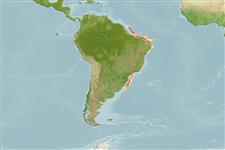Elasmobranchii (sharks and rays) >
Carcharhiniformes (Ground sharks) >
Atelomycteridae (Coloured catsharks)
Etymology: Schroederichthys: In honor of American ichthyologist William C. Schroeder (1895-1977), Woods Hole Oceanographic Institution, for his pioneering work (with Henry B. Bigelow) on cartilaginous fishes; ichthyos (Gr.), fish (See ETYFish); saurisqualus: saurus, from sauros (Gr.), lizard; squalus (L.), a sea-fish, usually applied to sharks, from vernacular “lizard catshark,” presumably referring to its slender, lizard-like body and long tail (See ETYFish).
Eponymy: William Charles Schroeder (1894–1977) was an American oceanographer and ichthyologist. [...] (Ref. 128868), visit book page.
Environment: milieu / climate zone / depth range / distribution range
Ecology
Marine; bathydemersal; depth range 122 - 435 m (Ref. 56497). Deep-water
Southwest Atlantic: southern Brazil.
Size / Weight / Age
Maturity: Lm ? range ? - 69 cm
Max length : 58.2 cm TL male/unsexed; (Ref. 56497); 69.2 cm TL (female)
Short description
Identification keys | Morphology | Morphometrics
Diagnosis: This species is differs from S. tenuis in size at maturity, males 57.8 cm (vs. 42.8) and females 69.2 cm (vs. 37); maximum total length , males 58.8 cm (vs. 46.8) and females 69.2 cm (vs. 42.6); color pattern presence of white spots (vs. none); in having longer interdorsal space, 20.7-22.3% (vs. 17.2-20.6%); longer pelvic-anal space 19.2-20.8% (vs. 14.7-19.4%); dermal denticles morphology, rounded (vs. pointed); and, greater number of vertebrae, 120-123 (vs. 108-113) (Ref. 56497).
Found in deep-reef habitat on the continental slope, generally in depths greater than 250 meters (122-435 m), with deepwater gorgonians, hard corals, tube sponges, crinoids, ophiuroids, and a great number of sympatric scyliorhinid shark Scyliorhinus haeckelii (Ref. 56497). Oviparous (Ref. 50449); with one egg per oviduct laid at a time. Egg capsule grayish olive (fresh) to brownish (fixed), with filamentous superficial texture (Ref. 56497).
Life cycle and mating behavior
Maturity | Reproduction | Spawning | Eggs | Fecundity | Larvae
Oviparous, paired eggs are laid. Embryos feed solely on yolk (Ref. 50449).
Soto, J.M.R., 2001. Schroederichthys saurisqualus sp. nov., (Carcharhiniformes, Scyliorhinidae) a new species of catshark from southern Brazil, with further data on Schroederichthys species. Mare Magnum 1(1):37-50. (Ref. 56497)
IUCN Red List Status (Ref. 130435: Version 2024-1)
Threat to humans
Harmless
Human uses
Fisheries: of no interest
Tools
Special reports
Download XML
Internet sources
Estimates based on models
Preferred temperature (Ref.
123201): 12.2 - 18.1, mean 15.5 °C (based on 15 cells).
Phylogenetic diversity index (Ref.
82804): PD
50 = 0.5312 [Uniqueness, from 0.5 = low to 2.0 = high].
Bayesian length-weight: a=0.00389 (0.00180 - 0.00842), b=3.12 (2.94 - 3.30), in cm total length, based on all LWR estimates for this body shape (Ref.
93245).
Trophic level (Ref.
69278): 3.8 ±0.3 se; based on size and trophs of closest relatives
Resilience (Ref.
120179): Very Low, minimum population doubling time more than 14 years (Fec = 2).
Fishing Vulnerability (Ref.
59153): Moderate to high vulnerability (48 of 100).
